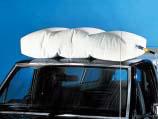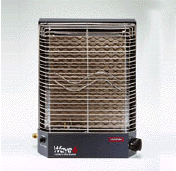|
|
||
|
|
|
|
|
|
||
Boondocking Made Easier
|
|
|
|
|
|
Copyright © 2002-2017 John Mayer. All rights reserved. For reuse policy see Reuse Policy Boondocking, or "dry camping", is generally thought of as camping without any hookups. Some would argue that true "boondocking" means camping in a secluded area, like the desert or forest, whereas "dry camping" could be in a Wal-Mart parking lot, at a truck stop or an RV Rally. In any case, what is important for this discussion is that you have no hookups available to you. You are "on your own".
Besides power management issues, covered extensively in other areas,
effective boondocking requires potable water management, waste
management, and more effective heating than a standard RV is
equipped for. These items are covered lightly here.
Water Management
When boondocking you have have a finite amount of water. One of the
biggest issues is getting more fresh water. Besides conservation
methods people use many techniques to fetch fresh water, depending
on how avid they are about boondocking. Long-term boondockers
usually have large (over 55 gallon) fresh water storage containers
for getting water. Often, several drums. Sometimes these are
permanently built into their tow vehicles - other times they are
temporarily used. Some avid boondockers build in plastic tanks to
their tow vehicles. These tanks may be found most readily at farm
supply stores, and come in various sizes and shapes.
We prefer using a flexible plastic water bladder. When not in
use this bladder takes up little room, yet it hold 45 gallons of
water. The picture shows this on the roof of a truck, which we
have done. But with the Volvo tractor we carry it on the bed. We
have driven 5-6 miles with it on the pickup roof, though (but
slowly). We generally gravity feed this into our water tank, but
if necessary we can pump it with a spare water pump for the RV.
Carrying the extra water pump allows us to pump water, and also
is the backup pump for the RV, in case our primary pump breaks.
Some people use boat bilge pumps for this purpose. We got our
water bladder at Camping World, and have been using it for
years. It costs about $85, but we feel it is well worth it for
the convenience. We supplement the 45 gallon bladder
with two collapsible five gallon carriers. You can find these at
Wal-Mart or most outdoor stores for under $10. We like them
because we can easily carry them in the back of the Jeep, and
whenever in town we pick up 10 gallons of water. They are easy
to handle, and take up little room when not in use. We are not
making special trips for water - simply picking up 10 gallons
when doing other things. This greatly extends our water supply,
and in many cases means we do not have to make a special trip
with the large bladder.
Waste Management
Waste management falls into grey and black water management. Often,
grey water can be dumped on the ground, and we do not hesitate to do
this, where it is appropriate. Our grey water is screened for food
particles and is pretty "clean". In our opinion this causes no harm,
but we leave that determination to you. We don't do this in
campgrounds or parking lots, but in dispersed boondocking situations
it is an effective way to dispose of gray water. Where it is not
appropriate to
dump grey water we use our "blue boy" to take the grey to the dump
station, along with the black water. There are many discussions of
dumping grey water on the various camping forums - with some very
radical opinions on both sides of the issue. Read them and form your
own opinion, but please don't dump grey where it causes a nuisance.
Black water has to be removed to a dump site. We either pull our
trailer out, or use a "blue boy", depending on the circumstances and
how far the dump site is from our location. Our blue boy is the 25
gallon model with 4 wheels. We can easily pull it behind the truck/Jeep,
or by hand. We also have a macerator pump, which allows us to pump
waste water into the blue boy. We place the blue boy in the truck
bed and pump the waste into it. This makes transport more convenient
and saves us from pulling the rig out. To dump, you use the standard
3" sewer hose. With our current trailer we can easily go 25 days on
our black tank so black tank dumping is not a big issue.
Heating
Your furnace wastes a lot of heat, and uses a lot of 12-volt power
doing it. The standard RV furnace is only about 50% efficient. If you doubt this
go outside and place your hand near the furnace vent when it is
running. Using a catalytic heater or blue flame/ceramic brick
propane heater is more
efficient, and also uses no power. We used a catalytic heater for
many years and there is no smell at all with it. Some people are affected by
the blue flame/brick heaters, although we cannot smell them. Check it out
for yourself...all work well.
Our Wave 6 has the following characteristics:
After using our first Wave 6 for six years it was time to replace the pad. Catalytic heaters do not burn with an open flame, but depend on a chemical reaction that occurs in the pad to supply the heat. When the pad ages, or is contaminated with dust or "bad" propane it needs to be replaced. For this reason it is important to keep a cat heater covered when not in use - a pillow case does a good job, or you can buy a special cover. A pad that needs replacing will not provide for clean combustion which will result in increased levels of CO. If you watch your detector display you will see this increase over time. A properly vented heater, with a good pad, should show no CO on the detector. Rather than send our original unit into the factory for refurnishing we bought a new Wave 6 on sale at Camping World. This new unit operated properly for a couple of weeks, but then we started smelling propane. We contacted the manufacturer and returned the unit for repair. Shipping cost $45, which was not covered under warranty. The diagnosis was a "bad pad due to contamination". On return of the unit we again used it for a couple of weeks and the same thing happened again. We were NOT impressed with this new cat heater and rather than put money into it again we replaced it with a non-catalytic heater. In researching heaters and talking to vendors we discovered that many of the Wave catalytic heaters were having similar problems with the pads. Some vendors were discontinuing sales of the Waves because of the service issues. We don't know why this is occurring, but I suspect that the pads being used are not of the same quality as in the past. Hopefully, Olympian will fix this issue, but we are soured on catalytic heaters for awhile (this occurred in the winter of 2007/2008, things may be different now).
|
|
|
|
||

